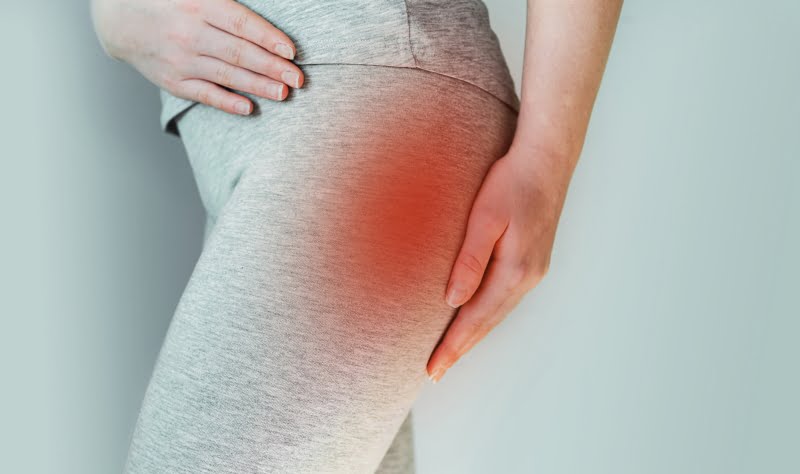Hip pain can be debilitating, affecting one’s ability to perform daily activities and causing discomfort. One common cause of hip pain is piriformis hip pain. In this article, we will explore what piriformis hip pain is, its causes, symptoms, diagnosis, and various treatment options. We will also discuss preventive measures and lifestyle modifications to manage this condition effectively.
Contents
- 1 What is Piriformis Hip Pain?
- 2 Understanding the Anatomy of the Piriformis Muscle
- 3 Causes of Piriformis Hip Pain
- 4 Symptoms of Piriformis Hip Pain
- 5 Diagnosing Piriformis Hip Pain
- 6 Non-Surgical Treatment Options
- 7 Surgical Treatment Options
- 8 Recovery and Rehabilitation
- 9 Preventing Piriformis Hip Pain
- 10 The Importance of Proper Posture and Body Mechanics
- 11 Conclusion
What is Piriformis Hip Pain?
Piriformis hip pain, also known as piriformis syndrome, is a condition characterized by pain and discomfort in the buttock region, often extending down the back of the leg. It occurs when the piriformis muscle, located deep in the buttocks, becomes irritated or inflamed, leading to compression or irritation of the sciatic nerve.
The piriformis muscle is a small, pear-shaped muscle that plays a crucial role in hip movement and stability. It helps to rotate the hip joint and stabilize the pelvis during activities such as walking, running, and sitting. However, in some individuals, the piriformis muscle can become tight or spasmodic, leading to compression of the nearby sciatic nerve.
The sciatic nerve is the longest in the body, running from the lower back through the buttocks and down each leg. When the piriformis muscle irritates or compresses the sciatic nerve, it can cause pain and other symptoms, collectively known as piriformis hip pain.
Understanding the Anatomy of the Piriformis Muscle
The piriformis muscle is a small, flat, and triangular-shaped muscle located deep within the buttock region, underneath the larger gluteal muscles. It runs from the sacrum, the triangular bone at the base of the spine, to the upper part of the femur (thighbone).
Here are some key aspects of the piriformis muscle’s anatomy:
- Origin and Insertion: The piriformis muscle originates from the anterior (front) surface of the sacrum, specifically from the second to fourth segments of the sacrum. It then travels diagonally across the pelvis and inserts onto the upper part of the greater trochanter of the femur, a bony prominence on the side of the hip.
- Relation to the Sciatic Nerve: One of the essential aspects of the piriformis muscle is its relationship with the sciatic nerve. In most individuals, the sciatic nerve passes beneath the piriformis muscle. However, in some cases, the sciatic nerve can run through the muscle or have multiple branches around it. This anatomical variation is significant because it can lead to compression or irritation of the sciatic nerve, resulting in piriformis syndrome.
- Function: The primary function of the piriformis muscle is to assist in the external rotation of the hip joint. When the hip is flexed (bent), the piriformis muscle helps to turn the thigh outward. Additionally, it also plays a role in stabilizing the pelvis during various lower-body movements, such as walking, running, and standing.
- Blood Supply and Innervation: The piriformis muscle receives its blood supply from the inferior gluteal artery, which is a branch of the internal iliac artery. It is innervated by the branches of the sacral plexus, specifically the nerve roots S1 and S2.
- Interplay with Other Muscles: The piriformis muscle works in conjunction with other muscles in the buttock region, such as the gluteus maximus, gluteus medius, and other deep hip rotators. These muscles collectively contribute to the stability and movement of the hip joint.
Causes of Piriformis Hip Pain
Several factors can contribute to the development of piriformis hip pain. Some common causes include:
- Muscle Overuse: Engaging in repetitive activities or sports that involve frequent hip movement can lead to overuse of the piriformis muscle, causing pain and discomfort.
- Sciatica: Piriformis hip pain is closely associated with sciatica, a condition where the sciatic nerve is compressed or irritated by the piriformis muscle.
- Trauma or Injury: A direct blow or injury to the hip area can result in piriformis hip pain.
- Piriformis Syndrome: This syndrome occurs when the piriformis muscle spasms and compresses the sciatic nerve, leading to pain and numbness in the buttocks and leg.
- Structural Issues: Anatomical abnormalities or imbalances in the hip region can contribute to piriformis hip pain.
Symptoms of Piriformis Hip Pain
The symptoms of piriformis hip pain can vary from person to person but may include:
- Dull, aching pain in the buttocks.
- Pain that radiates down the back of the thigh.
- Numbness or tingling sensation in the leg.
- Difficulty in sitting or standing for prolonged periods.
Diagnosing Piriformis Hip Pain
Diagnosing piriformis hip pain involves a combination of physical examination, imaging tests, and sometimes, nerve studies. Some common diagnostic methods include:
- Physical Examination: A thorough physical examination by a healthcare professional to assess the range of motion, tenderness, and muscle strength.
- Imaging Tests: X-rays, MRI, or CT scans may be performed to identify structural abnormalities or rule out other potential causes of hip pain.
- Electromyography (EMG) and Nerve Conduction Studies (NCS): These tests help assess the electrical activity and functioning of the nerves, including the sciatic nerve.
- Differential Diagnosis: It is essential to differentiate piriformis hip pain from other conditions with similar symptoms, such as lumbar disc herniation or hip osteoarthritis.
Non-Surgical Treatment Options

In most cases, piriformis hip pain can be effectively managed with non-surgical treatments. Some common non-surgical approaches include:
- Rest and Activity Modification: Giving the affected hip adequate rest and avoiding activities that exacerbate the pain.
- Physical Therapy: A customized physical therapy program to strengthen the hip muscles, improve flexibility, and correct biomechanical issues.
- Stretching and Strengthening Exercises: Specific exercises to stretch the piriformis muscle and adjacent muscles can reduce pain and improve mobility.
- Heat and Ice Therapy: Alternating between heat and ice applications can help reduce inflammation and alleviate pain.
- Medications: Over-the-counter pain relievers, muscle relaxants, or anti-inflammatory drugs may be prescribed to manage pain and inflammation.
- Injection Therapies: Corticosteroid injections or nerve blocks may be used to provide temporary pain relief.
Surgical Treatment Options
In cases where conservative treatments do not provide sufficient relief, surgical intervention may be considered. Some surgical treatment options for piriformis hip pain include:
- Piriformis Muscle Release Surgery: This procedure involves releasing the tight piriformis muscle to relieve pressure on the sciatic nerve.
- Sciatic Nerve Decompression Surgery: Surgery to decompress the sciatic nerve by removing the portion of the piriformis muscle causing compression.
Recovery and Rehabilitation
The primary goal of recovery is to alleviate pain, reduce inflammation, and restore normal function and mobility. Rehabilitation, on the other hand, focuses on strengthening and stretching the affected area to prevent future injuries and improve long-term outcomes. Here are some key aspects of recovery and rehabilitation for piriformis hip pain:
- Rest and Activity Modification: Rest is an essential part of the initial recovery process. Avoid activities that exacerbate the pain and put a strain on the hip. Modify your daily activities to reduce the pressure on the piriformis muscle, such as avoiding prolonged sitting or activities that involve repetitive hip movements.
- Gradual Return to Activities: As the pain and symptoms improve, gradually reintroduce activities that were avoided during the recovery phase. Pay attention to any signs of discomfort and avoid pushing yourself too hard too quickly.
- Continuing Maintenance: Even after recovery, it’s essential to continue with exercises and lifestyle modifications that promote hip health. Regular stretching and strengthening exercises can help prevent the recurrence of piriformis hip pain and enhance overall hip function.
Preventing Piriformis Hip Pain

While it may not always be possible to prevent piriformis hip pain entirely, some preventive measures can reduce the risk. These include:
- Maintaining Proper Posture: Practicing good posture can alleviate stress on the hip muscles and reduce the likelihood of developing hip pain.
- Regular Exercise: Engaging in regular physical activity can strengthen the hip muscles and improve overall joint health.
- Proper Warm-Up and Stretching: Before engaging in physical activities, warm-up exercises and stretching can prepare the muscles for the activity and prevent injuries.
- Avoiding Prolonged Sitting: Taking breaks and avoiding prolonged sitting can help prevent muscle imbalances and alleviate hip pain.
The Importance of Proper Posture and Body Mechanics
Whether sitting, standing, or engaging in physical activities, here’s why proper posture and body mechanics are essential:
- Reduced Musculoskeletal Strain: Good posture distributes the forces exerted on the body more evenly, reducing the strain on muscles, ligaments, and joints. Improper posture, on the other hand, can lead to muscle imbalances, tension, and unnecessary stress on specific body parts, increasing the risk of overuse injuries and chronic pain.
- Improved Spinal Alignment: Proper posture helps maintain the natural curves of the spine, including the cervical, thoracic, and lumbar curves. When the spine is in its natural alignment, the intervertebral discs are better protected. It reduces the risk of disc herniation and nerve impingement.
- Enhanced Breathing and Circulation: Good posture allows the lungs to expand fully, facilitating optimal breathing. Proper body mechanics also ensure that blood vessels are not compressed or restricted, promoting better circulation and oxygen delivery to tissues.
- Support for Pelvic and Hip Health: Proper alignment of the pelvis and hips is essential for stability and mobility. Good posture helps prevent excessive pressure on the hip joints, reducing the risk of conditions like piriformis hip pain and hip osteoarthritis.
Conclusion
Piriformis hip pain can significantly impact a person’s quality of life, but with early diagnosis and appropriate treatment, individuals can find relief and regain their mobility. Non-surgical treatments, including physical therapy and exercise, are usually the first line of management. However, in severe cases, surgical intervention may be necessary. Preventive measures, such as maintaining proper posture and engaging in regular exercise, can reduce the risk of developing piriformis hip pain. If you’re experiencing Hip pain, physical therapy for hip pain at PhysioMantra can help: Book an online physical therapy session.



